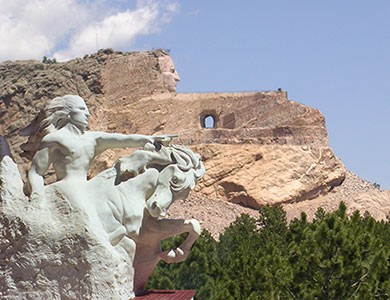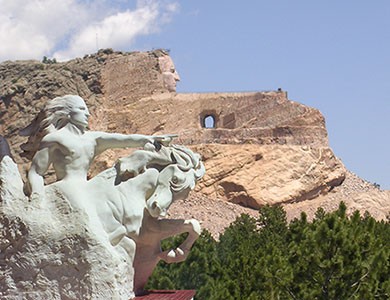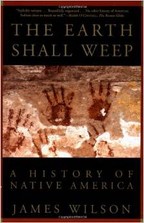Crazy Horse Memorial
Introduction
Text-to-speech Audio
Images
This photo shows a model of the sculpture in the foreground and the current state of the massive monument in the background.


The Journey of Crazy Horse: A Lakota History-Click the link below for more information about this book

The Earth Shall Weep: A History of Native America-Click the link below for more information about this book

Backstory and Context
Text-to-speech Audio
Crazy Horse was born around 1840 and was a leader of the Oglala Lakota tribe of present-day South Dakota. Crazy Horse’s original name was Tashunka Witco. Later on, he acquired the name Crazy Horse from his father who was also named Crazy Horse by demonstrating his excellent skills as a warrior. After seeing the death of the Lakota leader Conquering Bear, Crazy Horse began to have trances so his father took him on a vision quest. Crazy Horse received a Black stone from a medicine man named Horn Chips to protect his horse which made him believe that he and his horse were one in battle.
Lakota People
Crazy Horse (Tashunka Witko) was a Lakota Native American who came from the ancestors of Lakota Native Americans. Lakota Native Americans are viewed as the first settlers of North America. The Lakota Indian's essential area is in South Dakota and North Dakota. The Lakota tribe mainly stays on or around the reservation of South Dakota. The word Lakota stands for the alliance of people distinguished by family connection with the Lakota, Dakota, and Nakota people. Moreover, this specific Indian tribe communicates in the Lakota language. The Lakota Indians can also be followed back to the Lewis and Clark campaign. During this time, the Lakota Indian people played a significant part in the Great Plains. Due to progressing fighting, the Lakota Indians constrained northward and settled in the Dakotas.
Military Involvement
Through the late 1850s to the early 1860s, Crazy Horse's reputation as a warrior grew through the Lakota tribe. In 1864, he joined with other tribes to fight the US military following the Sand Creek Massacre. In 1865, he earned the title Ogle Tanka Un which meant war leader. On December 21, 1866, Crazy Horse and six other warriors, both Lakota and Cheyenne, decoyed Capt. William Fetterman's 53 infantrymen and 27 cavalry troopers under Lt. Grummond into an ambush. The Lakota warriors swept over the hill and attacked the infantry. Additional Cheyenne and Lakota hiding in the buckbrush along Peno Creek effectively surrounded the soldiers. Seeing that they were surrounded, Grummond headed his cavalry back to Fetterman. The combined warrior forces of nearly 1,000 killed all the US soldiers, in what became known at the time to the white population as the Fetterman Massacre. It was the Army's worst defeat on the Great Plains up to that time.
On the morning of September 5, 1877, Crazy Horse and Lieutenant Lee accompanied by Touch the Clouds as well as a number of Indian scouts, departed for Fort Robinson. Arriving that evening outside the adjutant's office, Lieutenant Lee was informed that he was to turn Crazy Horse over to the Officer of the Day. Lee protested and hurried to Bradley's quarters to debate the issue, but without success. Bradley had received orders that Crazy Horse was to be arrested and taken under the cover of darkness to Division Headquarters. Lee turned the Oglala war chief over to Captain James Kennington, in charge of the post guard, who accompanied Crazy Horse to the post guardhouse. Once inside, Crazy Horse struggled with the guard and Little Big Man and attempted to escape. Just outside the door, Crazy Horse was stabbed with a bayonet by one of the members of the guard. He was taken to the adjutant's office, where he was tended by the assistant post surgeon at the post, Dr. Valentine McGillycuddy, and died late that night.
Origins
Korczac Ziolkowski was brought to South Dakota to help Gutzon Borglum in the building of Mount Rushmore. During the building of Mount Rushmore, the Lakota Chief Henry Standing Bear reached out to Korczac Ziolkowski stating, “my fellow chiefs and I would like the white man to know the red man has great heroes, too." Korczac Ziolkowski was driven by Chief Henry Standing Bear’s statement to construct the Monument of Crazy Horse in honor of Crazy Horse and the Native American People. With no government assistance, Ziolkowski started the Memorial of Crazy Horse in the Black Hills of South Dakota on June 3, 1948. On July 6, 1955, a report on a Public Bill was reported by the House and Senate. The Document title stated: ”Establishing the Crazy Horse Memorial Commission to provide for the construction of a permanent national memorial to the North American Indians.”
This bill passed by the House and Senate allowed the construction of the Crazy Horse Monument to take place in Black Hill’s, South Dakota. This Public Bill allowed the Monument of Crazy Horse to be nationally recognized in the United States as a memorial to the Native Americans. At the Standing Bear’s request, Mr. Ziolkowski dedicated the remainder of his life to bring into existence a monument that would honor Crazy Horse and the Native American people. During the year 1982, Mr. Ziolkowski passed away and the unfinished Crazy Horse Monument was passed along to his wife Ruth. With no prediction of when the Monument of Crazy Horse would be completed, Ruth began the job her husband Korczac Ziolkowski started and found ways of bringing in funds like donations and gifts to complete the monument.
Memorial Controversy
The Black Hills in South Dakota once used to be a sacred home to all Native Americans, but particularly sacred to the Lakota Sioux. The Lakota Sioux are voiceless while witnessing a land of the sacred ground being carved apart. Within the sacred Black Hill’s, there is a monument that is slowly being carved up to life called Crazy Horse. The Monument Crazy Horse is created to honor all Native Americans and Crazy Horse, but the carving of Crazy Horse challenges many Lakota and Native American’s beliefs and traditions. The usage of the land is not being met in the eyes of the Lakota Native Americans. Many traditional Lakota is against the memorial of Crazy Horse. In 1972 an autobiography by John Fire Lame, a Lakota who was known as a medicine man, stated, "The whole idea of making a beautiful wild mountain into a statue of him is a pollution of the landscape. It is against the spirit of Crazy Horse” (Simon and Schuster. P. 96). Russell Means who is an activist for the Lakota people also stated "Imagine going to the holy land in Israel, whether you're a Christian or a Jew or a Muslim, and start carving up the mountain of Zion. It's an insult to our entire being. It's bad enough getting four white faces carved in up there, the shrine of hypocrisy. (Roberts, September 2001).
According to the majority, this is primarily an insult to Native American’s entire being, due to the fact that Standing Bear who was the main proponent of the carving did not consult with other Lakota Sioux community members. This was the main disconnect between the project of the Crazy Horse Monument and the Lakota people. The brokenness of the memorial in its present-day nation appears to mirror the Lakota human beings themselves, seemingly shattered after years of heartbreak, loss and forced assimilation. (White Face Interview 2013). The incompletion of the Memorial Crazy Horse represents the Lakota people, The Lakota, and Native American people are witnessing a memorial being built in their honor on a sacred ground that they did not wish for. The Lakota and Native American voice of terror is being unheard while their land is being polluted by tourism. The plan to construct the memorial resulted in controversy as many members among the Lakota community are in opposition to the idea.
Sources
Britannica, T. E. of E. (n.d.). Black Hills. Retrieved from https://www.britannica.com/place/Black-Hills.
Building on the DreamBecome a Storyteller. (n.d.). Retrieved from https://donate.crazyhorsememorial.org/.
Carving Crazy Horse Mountain. (n.d.). Retrieved from https://crazyhorsememorial.org/story/the-mountain/carving-crazy-horse-mountain.
Crazy Horse - Death. (2019, April 12). Retrieved from https://www.biography.com/video/crazy-horse-death-24517699789.
Crazy Horse Memorial. (n.d.). Retrieved from https://www.visitrapidcity.com/crazy-horse-memorial.
Crazy Horse Death... (n.d.). Retrieved from http://www.rarenewspapers.com/view/588560.
Crazy Horse monument led by 3 after the death of the widow. (2014, May 23). Retrieved from https://www.csmonitor.com/USA/Latest-News-Wires/2014/0523/Crazy-Horse-monument-led-by-3-after-death-of-widow.
Dorminey, B. (2011, January 7). The Crazy Horse Memorial - What Would Crazy Horse Think? Retrieved from https://psmag.com/social-justice/making-sense-of-the-crazy-horse-memorial-26689.
Lame Deer, John (Fire); Erdoes, Richard (1972). Lame Deer, Seeker of Visions. New York: Simon and Schuster. p. 96.
LaRocque, Taylor. The Crazy Horse Memorial: A Study of a Sacred and Contested Landscape (2014): ProQuest Dissertations and Theses.
LaRocque, T. D. (2014). The crazy horse memorial: A study of a sacred and contested landscape (Order No. MS26232). Available from ProQuest Dissertations & Theses Global. (1516593928). Retrieved from http://www2.lib.ku.edu/login?url=https://search.proquest.com/docview/1516593928?accountid=14556
Petersonlund, R. and Bunkers, S. (2018). "The Living Experience of Suffering: Lakota Voices." Nursing Science Quarterly 31.1: 36-46.
Roberts, Chris (September 2001). "Russell Means, in Memoriam". The Progressive. Retrieved October 24, 2012.
Rose, M. (n.d.). Lakota Indians. Retrieved from http://indians.org/articles/lakota-indians.html.
Smigelski, S. (2015, August 16). Crazy Horse Volksmarch in the Black Hills. Retrieved from https://www.hikespeak.com/trails/crazy-horse-memorial-volksmarch/.
Special Events. (n.d.). Retrieved from https://crazyhorsememorial.org/visit/special-events.
U.S. Congress. (2008). Web.
U.S. Congress. House Committee on Interior Insular Affairs. (1955). Web.
Visitor Feedback Survey. (n.d.). Retrieved from https://crazyhorsememorial.org/visitor-feedback-survey.
